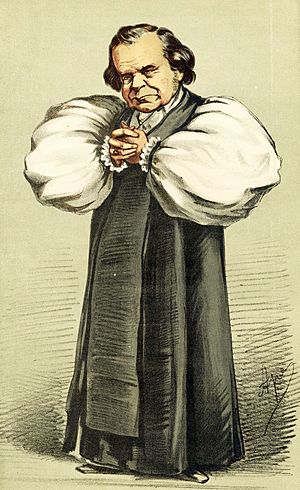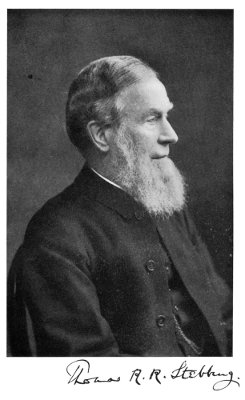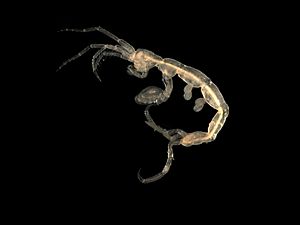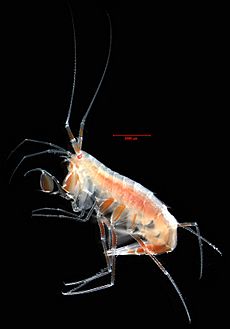Thomas Roscoe Rede Stebbing facts for kids
Thomas Roscoe Rede Stebbing (born February 6, 1835, in London – died July 8, 1926, in Royal Tunbridge Wells) was a British zoologist. He once said he was "a worker for natural history, mainly studying Crustacea". He went to school in London and Oxford. He only started studying nature seriously when he was in his thirties, after working as a teacher. Even though he was a priest, Stebbing supported Darwinism (the idea of evolution). Because of this, he was not allowed to preach in church. His scientific work mostly focused on crustaceans, especially tiny ones called Amphipoda and Isopoda. His most famous work was about the amphipods found during the Challenger expedition.
His short name used in science is Stebbing.
About Thomas Stebbing

Thomas Roscoe Rede Stebbing was born on February 6, 1835, in London. He was one of many children born to Henry Stebbing, who was a clergyman and editor. Thomas went to King's College School and then King's College, London, where he studied old languages and history. He earned his first degree in 1855. Later, he studied at Worcester College, Oxford, getting another degree in law and history in 1857.
Around this time, he taught at schools like Radley College and Wellington College. He became a priest in the Church of England in 1859.
By 1863, Stebbing was a tutor in Reigate, Surrey. There, he met William Wilson Saunders, who studied insects. Saunders' daughter, Mary Anne, was a talented botanist (plant scientist) and artist. Stebbing started studying natural history around this time. He married Mary Anne in 1867. They moved to Torquay, Devon, where Stebbing continued teaching. He also began writing about religion, Darwin's ideas, and nature.
In 1873, Stebbing wrote his first paper about crustaceans. The next year, he started focusing on Amphipoda. In 1877, Stebbing moved to Royal Tunbridge Wells. He wanted to be closer to London's libraries, museums, and science groups. As he earned more money, he stopped teaching and spent all his time writing. He passed away in his home on July 8, 1926. His wife died just a few months later.
Evolution and His Beliefs
Stebbing was trained to be a priest and expected to disagree with Charles Darwin's new idea of natural selection (how living things change over time). But Stebbing said that after reading Darwin's book, The Origin of Species, he became a strong supporter instead. He decided to combine his religious beliefs with scientific reasoning.
After a critical review of Darwin's book The Descent of Man in a newspaper in 1871, Stebbing became well-known for defending Darwin in the science magazine Nature.
Stebbing wrote several essays about Darwin's ideas. In these writings, he explained why he supported evolution and questioned some traditional Christian beliefs. Because he spoke out so strongly, he was not allowed to preach in church again. He was never given his own church to lead.
Studying Crustaceans
Most of Stebbing's scientific work, which included over 110 papers, was about amphipod crustaceans. These are small creatures, often found in the ocean. A scientist named A. M. Norman suggested that Stebbing write a detailed book about the amphipods collected during the 1872–1876 Challenger expedition. Stebbing did this, describing every type of amphipod found and listing all the related research.
He also wrote a book about another group of crustaceans called Cumacea. He wrote a general book about crustaceans and a life story of a Scottish naturalist named David Robertson. In 1906, Stebbing published a volume on Gammaridea for a German science series.
His Impact
Stebbing became a respected member of the Linnean Society in 1895 and the Royal Society in 1896. These are very old and important science groups in Britain. In 1908, he received the Gold Medal of the Linnean Society, a high honor. He strongly pushed for women to be allowed to join the Linnean Society, and his efforts helped make it happen. His wife was one of the first women to become a member.
Many animal species have been named after Stebbing to honor his work. Here are some of them:
- Hyale stebbingi (a type of amphipod)
- Parapodascon stebbingi (a type of isopod)
- Phronima stebbingii (another type of amphipod)
- Metapenaeus stebbingi (a type of shrimp)
- Protellopsis stebbingii (a type of amphipod)
- Sphyrapus stebbingi (a type of tanaidacean)
- Macropisthopus stebbingi (another type of amphipod)
- Carpias stebbingi (a type of isopod)
- Pardaliscoides stebbingi (another type of amphipod)
See also
- Category:Taxa named by Thomas Roscoe Rede Stebbing




